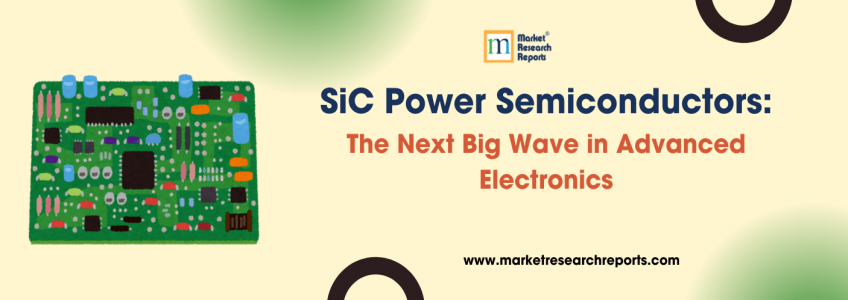SiC Power Semiconductors: The Next Big Wave in Advanced Electronics

Silicon carbide (SiC) is increasingly viewed as a superior semiconductor material for power devices, promising significant advancements over traditional silicon (Si) in various high-voltage and power applications. The unique properties of SiC allow it to outperform silicon in critical areas, making it a potentially transformative material in power electronics.
SiC, a robust compound of silicon and carbon, exhibits outstanding properties that make it ideal for high-power applications. It has a bandgap almost three times that of silicon, which translates into higher breakdown electric fields and the ability to operate at elevated temperatures. Additionally, its thermal conductivity is significantly superior, ensuring effective heat dissipation even under stressful conditions.
1 . Salient Features of SiC
High Breakdown Strength and Efficiency
One of the key advantages of SiC is its high breakdown strength, which is approximately ten times greater than that of silicon. This attribute enables SiC-based devices to handle much higher voltages and power levels with lower leakage currents. The inherent efficiency of SiC in terms of energy usage and its ability to minimize power losses significantly enhances device performance, especially in high-voltage applications. Devices made from SiC can sustain higher voltages with thinner layers, which reduces the overall material usage and potentially lowers manufacturing costs.
Enhanced Thermal Performance
The ability of SiC to operate at higher temperatures is another critical advantage. Unlike silicon devices, which are limited by lower thermal thresholds, SiC devices can function effectively at temperatures well above 300°C. This capability translates to better performance and reliability under harsh operational conditions, reducing the need for extensive cooling systems and thus simplifying system design and reducing costs.
Revolutionary Impact on Power Electronics
Historically, the introduction of SiC has already reshaped the landscape of power electronics, particularly in the design of more efficient and compact devices. The transition from traditional silicon to SiC allows for more simplified circuits with improved performance metrics such as faster switching speeds and reduced losses. These improvements are particularly evident in demanding applications such as electric vehicles and renewable energy systems, where efficiency and durability are critical.
In short, key Benefits of SiC are: Higher Efficiency, Better Performance at High Temperatures, Faster Switching, Smaller Size, and Longer Lifespan.
2 . 4H-SiC Wafers:
4H-SiC wafers are made from a compound of silicon and carbon, which naturally forms a rugged crystal lattice. The '4H' denotes a specific polytype of the silicon carbide crystal structure characterized by a repeating unit cell of four silicon-carbon bilayers in a hexagonal configuration. This structure is particularly favorable for creating semiconductors due to its electrical and thermal properties.
Importance in High-Performance Semiconductor Applications
High Breakdown Voltage: 4H-SiC has a much higher breakdown voltage compared to silicon. This property makes it an excellent choice for power devices that need to handle high voltages without failure, reducing the risk of breakdowns in critical applications.
High Thermal Conductivity: Silicon carbide has superior thermal conductivity compared to silicon. This means that 4H-SiC devices can operate at higher temperatures and dissipate heat more effectively, which is crucial for maintaining performance and reliability in demanding environments.
Higher Efficiency: The electrical properties of 4H-SiC allow for devices with lower power losses. For instance, devices made from 4H-SiC exhibit lower on-resistance and can operate at higher frequencies. This leads to more efficient power conversion in applications such as electric vehicles, solar power inverters, and high-performance computing.
Durability and Longevity: Devices fabricated from 4H-SiC tend to show better durability and longer operational lifetimes under harsh conditions. This is due to the material's ability to withstand high energy and thermal stresses.
Enabling New Applications: The robustness of 4H-SiC in terms of voltage, temperature, and efficiency opens up new possibilities for applications where traditional silicon devices fall short. This includes high-power systems, RF and microwave applications, and settings with extreme environmental conditions.
Size and Cost Efficiency: As technology has advanced, the ability to produce larger diameter 4H-SiC wafers has reduced the cost and improved the scalability of producing devices based on this material. This makes it a more viable option for a wider range of applications, enhancing the economic aspect of high-performance semiconductor manufacturing.
3 . Market Overview of Silicon Carbide (SiC) Power Semiconductors
In 2023, the global market for Silicon Carbide (SiC) Power Semiconductors was valued at approximately US$ 1.163 billion. Projections suggest a significant growth trajectory, with an expected market value of US$ 7.065 billion by 2030. This represents a robust compound annual growth rate (CAGR) of 29.3% during the period from 2024 to 2030.
Trends in SiC Wafer Production
The Semiconductor Research Center reported that in 2022, the global market for SiC wafers was valued at US$ 750 million. Over the next six years, this market is expected to experience rapid growth, primarily driven by the burgeoning demand from the electric vehicle (EV) sector. Currently, 6-inch SiC substrates dominate the market. However, it is anticipated that within the next six years, an increasing number of manufacturers will begin production of 8-inch SiC wafers.
Geographical Dynamics and Future Projections
The major players in the SiC market are predominantly based in the United States, Europe, Japan, and China, with a particularly notable expansion in China. As more Chinese companies enter the market, it is forecasted that these firms will play a significant role in shaping the global SiC industry over the next decade.





